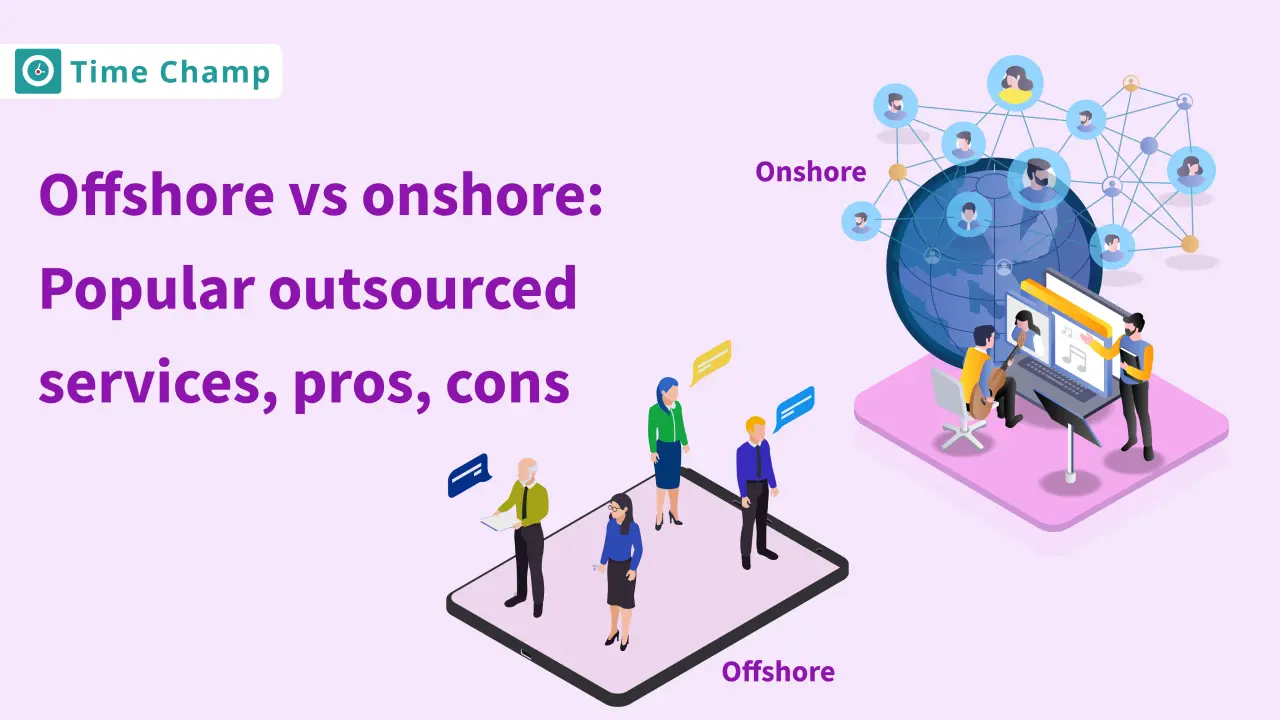Choosing between offshore and onshore (offshore vs onshore) outsourcing in a modern business environment involves strategic decisions that could have a major effect on a firm’s performance and revenue line.
The two approaches have distinct advantages and disadvantages therefore; businesses need to understand the discrepancies and purposes.
This blog will explain the topics of outsourcing, offshore vs onshore outsourcing, delving into their definitions and exploring both offshore and onshore options. This will look at the most popular services, pros and cons so that you can make a well-informed choice.
What is Outsourcing?
Outsourcing involves a company hiring another party external to it to provide services or manufacture goods that used to be done in-house by the company’s employees and staff. It is usually used to cut costs, enhance efficiency, and concentrate the firm on its competencies.
Outsourcing can be categorized mainly into two types: offshore and onshore. Both approaches have unique attributes and implications for businesses, which we will examine in detail.
Offshore vs Onshore: A Detailed Comparison
1. Offshore vs Onshore: Definitions
A. What is Offshoring?
Offshoring refers to the transfer of a business process or service from the home country to a foreign country, especially to take advantage of cheap labor. This strategy can be divided into two categories:
a. Offshore Company: Such a business is an entity that takes advantage of the tax benefits and conducive business environments of another nation.
b. Offshore Outsourcing: The process of hiring an external organization to offer its services outside the origin country of the products/services.
For instance, a U.S. company might choose to outsource its customer support services to an Indian company for affordable costs and 24/7 services.
B. What is Onshoring?
Onshoring is defined as outsourcing of business processes to a company in the same country as the one that does the outsourcing.
a. Onshore Company: It is a business enterprise located in the same country where it has been set, often for regulatory compliance and ease of coordination.
b. Onshore Outsourcing: Entering into a contract with local companies to provide services.
For instance, a technology company in California may outsource its software development to an IT company in Canada for cultural compatibility and ease of communication.
That being said, both offshoring and onshoring operations are commonly linked to the practice of outsourcing business processes. So, let’s see some of the popular offshore and onshore outsourced services.
2. Popularly Outsourced Services
A. Offshore Services
1. Information Technology
2. Customer Service
Customer services are even outsourced by companies as call centers to other regions or countries. This is an affordable method that enables companies to have continuous service provision across time zones.
For instance, a European e-commerce business locates its customer service unit in the Philippines with a view to utilizing the very high English proficiency of most Filipinos and the consequently low operating costs of such facilities. The customer service is available round the clock, catering to international customers worldwide.
3. Manufacturing
Oftentimes, manufacturing is outsourced offshore to exploit cheaper labor costs in different countries. Such a process could mean the manufacture of components or even products whose production would save a lot of labor and materials costs.
The U.S. clothing brand outsources the manufacturing of its garments to Bangladesh in order to take advantage of the low labor cost but designs and markets its garments in the U.S.
4. Accounting and Finance
For example, some companies might prefer outsourcing accounting and finance operations like bookkeeping, tax services, and financial analysis in offshore locations, since it is less expensive. It makes professional services cheap for businesses in the western part of the US and other countries.
For example, a Canadian company outsources its routine accounting and bookkeeping tasks to India and then saves costs by using them as cost drivers for its in-house team, which can then focus on more strategic financial planning.
B. Onshore Services
1. Software Development
Onshoring, in particular, may be very effective for situations where a project’s success depends on specialized, local knowledge and expertise. Enhanced focus on the local market needs, better communication, and collaboration is promoted by this approach, as a result of the time zone and proximity.
For example, the U.S.-based healthcare tech company employs a Silicon Valley-based local software development firm to develop health information systems compliant with U.S. healthcare protocols.
2. Marketing and Sales
Marketing and sale outsourcing is beneficial by virtue of the fact that local agents comprehend their local market, culture, and consumer behavior. This helps in coming up with better market strategies as well as sales campaigns.
As an example, an Australian beverage company hires an Australian marketing agency to take care of its marketing and sales strategy with a deep insight into the Australian consumer market and culture.
3. Legal Services
Such legal services as contract negotiations, compliance, and litigation are usually onshored since they require knowledge of local laws and regulations. This is important for a business to ensure that they fully adhere to the set of all the legal requirements within their home country.
For instance, in the UK, a real estate company outsources its property transaction needs to a local law firm that is conversant with the peculiarities of the UK real estate laws.
4. Human Resources
Onshoring human resources services, including recruitment, training, and employee management, is beneficial for companies looking to align these functions with the local work culture and legal environment.
Local HR teams are better equipped to handle recruitment and training that resonate with the local workforce.
In Germany, for example, a startup will use a German HR company that knows more about the job market and labor laws to recruit and train its employees.
3. Offshore vs Onshore: Advantages and Disadvantages
A. Advantages of Offshoring
1. Cost Efficiency
Offshoring has one huge advantage in the form of cost savings on operations and labor. This disparity in wages between offshore and onshore will result in very significant cost savings for companies. Outsourcing offshore operations in this aspect is especially attractive for companies with a limited budget.
2. Access to Global Talent
Offshoring allows a company to draw talent from millions of people who have diverse and highly specialized areas of expertise from all over the world. This is particularly important for sectors where skills or equipment are either rare or costly in domestic markets.
3. Round-the-Clock Operations
Due to the variation of time zones in onshore locations, businesses can run non-stop. Offshore outsourcing ensures the availability of operations such as customer service or IT support at all times and is one of its benefits.
4. Scalability
Scalability is a strength of offshoring which cannot be limited by local resources. Scalable operation of businesses is an important consideration in the onshore vs offshore outsourcing decision as it allows for scaling up and down, in response to changing market demands.
B. Advantages of Onshoring
1. Cultural Alignment
Onshore helps in adjusting better to the customs of the local market and the common language, as well as business practices. This insight is important in sectors whose market knowledge at the local level is critical and underscores the advantages of onshore outsourcing.
2. Easier Collaboration
Effective communication and faster problem-solving are made possible by onshoring that takes place in proximity. It is especially useful in projects where frequent communication is needed, underlining the distinction between onshore and offshore outsourcing in terms of co-operate efficiency.
3. Regulatory Compliance
Onshore companies are naturally in compliance with local laws and regulations thereby curbing legal and compliance risks. This is an important advantage given the complexities of jurisdictional legal frameworks for offshore operations.
4. Supporting Local Economy
Local job creation and local economic growth are paramount in the consideration of onshoring for businesses that seek to contribute to the growth of the home country’s economy.
C. Disadvantages of Offshoring
1. Communication Barriers
Differing languages and cultures in the offshore location may result in misinterpretations and influence with project’s final results. An important issue in the offshore versus onshore disparity argument.
2. Time Zone Challenges
One important consideration with offshoring is the challenges involved in coordinating among different time zones which may lead to delays and inefficiencies.
3. Quality Control
Quality control is generally more difficult to maintain among offshore operations, as processes are less direct in this context.
4. Political and Economic Risks
Outsourcing in offshore locations may bear political instability and economic fluctuation risks that may affect the stability of the contracts.
D. Disadvantages of Onshoring
1. Higher Costs
In shoring, the major drawback is high labor and operational costs, which is a key consideration in choosing between onshore or offshore.
2. Limited Talent Pool
Onshoring limits businesses to only talent that exists in a limited pool within a specific specialization.
3. Resource Availability
Resource scarcity could occur as a result of high demand for specified services onshore hence affecting project timelines and cost.
4. Less Operational Flexibility
The onshoring strategy is less flexible when considering scaling operations, an important factor in the onshore vs offshore outsourcing analysis.
How Time Champ Improves Productivity and Streamlines Outsourcing Processes
Time Champ is a software program that is used as a monitoring device and productivity booster for employees with onshore as well as offshore staff. It is aimed at helping employers gain insights into different employees’ behaviors in an effort to know more about their activities and their working patterns for companies that outsource services.
Here’s a brief overview of its features and how it can help improve productivity and streamline outsourcing processes:
- Activity Monitoring: The application tracks employee activities and gives details about the time spent on various tasks. This is an insight that identifies inefficiencies and time waste associated with operations.
- Productivity Analysis: The program allows the managers to detect low productivity levels among employees in some areas, hence they can determine areas they should train individuals or assist them accordingly.
- Time Tracking: The software also has a time tracking function that records the hours spent on a project or work by an employee, which is very crucial when undertaking contract-based tasks.
- Remote Monitoring: Time Champ also offers remote monitoring abilities for offshore teams where a manager can keep track of work processes from different places in order to maintain uninterrupted work.
- Reports and Analytics: It provides in-depth reports and analysis that show work patterns and productivity levels. This helps in informing decision-making on workforce management.
- Project Management Tools: Time Champ can easily communicate with project management tools to make the workflow smooth between onshore and offshore teams.
Through this, Time Champ can considerably boost productivity with outsourced operations. It offers vital information on employee performance, gives a clear idea about how to handle working teams at distant places, and keeps productivity consistent in the various geographical regions involved. The use of this tool is helpful for companies as it helps them to control both onshore and offshore outsourcing relationships.
Conclusion
In conclusion, both offshore and onshore outsourcing have their unique benefits and drawbacks. The choice depends on the specific needs, resources, and goals of your business. Whether it’s cost efficiency, expertise, cultural alignment, or operational flexibility, understanding these factors is key to making an informed decision.
To further enhance your business operations, consider utilizing Time Champ’s employee monitoring software. This robust tool is designed to monitor both onshore and offshore employees effectively, helping you improve productivity and streamline your outsourcing processes.
The primary distinction between the offshore and onshore differences lies in location and associated factors. Offshore outsourcing involves relocating business operations to a foreign country, often for cost savings and access to a global talent pool. Onshore outsourcing, on the other hand, refers to outsourcing within the same country, benefiting from cultural alignment and easier regulatory compliance.
Onshore outsourcing offers several advantages, including cultural alignment with the local market, language, and business practices, which can be crucial in sectors like marketing and legal services. It also facilitates easier collaboration and communication due to proximity and time zone alignment and ensures regulatory compliance with local laws and standards.
Offshoring presents challenges including communication barriers due to language and cultural differences, time zone complexities affecting coordination, and potential issues in maintaining consistent quality standards. Additionally, political and economic instability in offshore countries can pose risks to business operations.
Key considerations include cost efficiency, expertise required, regulatory environment, operational scalability, and the need for cultural alignment. The decision between onshore and offshore outsourcing should align with the company’s strategic goals, resource availability, and market demands.
Yes, onshoring can enhance business efficiency. By utilizing local talent and resources, companies benefit from improved communication, quicker decision-making, and alignment with local market dynamics. The benefits of onshore outsourcing in terms of cultural and regulatory alignment contribute significantly to operational efficiency.
Offshoring can significantly reduce costs, primarily due to lower labour expenses in offshore locations. Businesses can leverage the difference between onshore and offshore outsourcing costs to optimize their budget, especially in labour-intensive operations like manufacturing and customer service.
Industries like information technology, customer service, manufacturing, and finance often engage in offshore outsourcing to access cost savings and a diverse global talent pool. This approach is particularly beneficial for operations that are labor-intensive or require specialized skills not readily available in the domestic market.
Offshoring can lead to a reduction in certain types of jobs in the home country, as businesses move operations overseas to capitalize on lower costs. However, it can also open up opportunities for domestic businesses to focus on core competencies and invest in new areas, potentially creating new types of jobs.
Time Champ’s software provides robust monitoring and analytics tools that enhance the management of both offshore and onshore teams. It offers features like time tracking, productivity analysis, and screen monitoring, which are crucial for ensuring efficiency and accountability in remote work settings.







